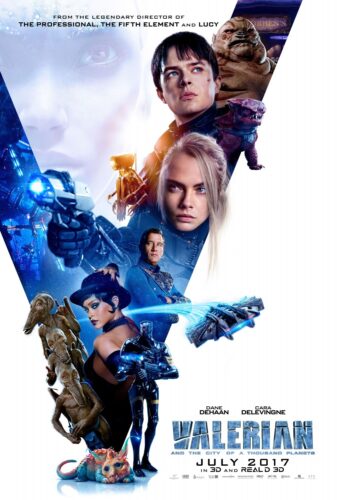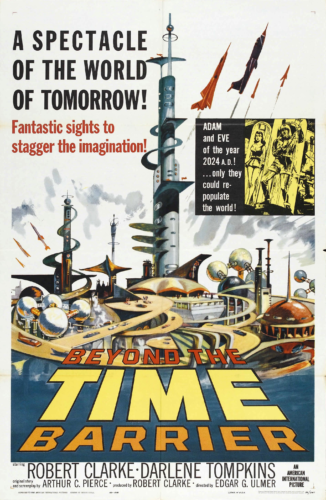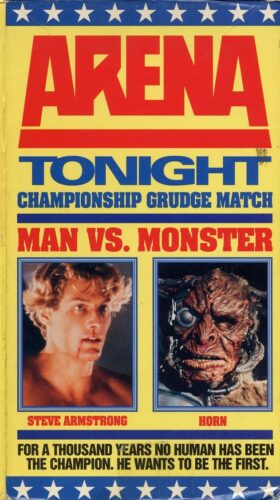 Valerian and the City of a Thousand Planets (2017) – I read a few of the translated Valerian graphic novels back in the day — nothing that this movie might or might not have been based on. I usually found those graphic novels a little underwhelming on the whole, and that’s something this movie can contribute in droves.
Valerian and the City of a Thousand Planets (2017) – I read a few of the translated Valerian graphic novels back in the day — nothing that this movie might or might not have been based on. I usually found those graphic novels a little underwhelming on the whole, and that’s something this movie can contribute in droves.
After a lengthy dialog-free intro about a pseudo-African alien race living in beautiful harmony without the depredations of Wypipo (until of course Evil Deadly Technology falls from the sky), we’re introduced to our protagonists: Valerian (Dane DeHaan), an ill-defined secret agent functionary who looks like a skinny emo seventeen-year-old, and his very competent gal-friday Laureline (Cara Delevingne), and their dialog… oh lord, their dialog. There’s on-the-nose, and then there’s on-the-nose-and-trying-to-swat-a-fly-on-your-nose-with-a-mallet. It was so cringeworthy it made clear in one scene why it didn’t make anyone’s favorites list; I longed to go back and spend more time with the happy space Africans whose language I couldn’t understand.
The movie does improve, but never to the point where suspending your disbelief is worth the effort. My favorite-to-criticize part: The space Africans, despite having a completely pre-industrial culture, manage to reverse-engineer advanced tech without help in a couple of decades, to the degree that they can hide from the makers of that technology right in the heart of their civilization. This is “Wakanda forever!” levels of wishful ignorance on how cultures actually work.
I truly liked exactly one scene, which isn’t enough.
 Beyond the Time Barrier (1960) – A military test pilot, caught in a time vortex caused by bad science, ends up in a ruined future teetering on the edge of complete human extinction. Good thing he’s “viable,” if you know what I mean.
Beyond the Time Barrier (1960) – A military test pilot, caught in a time vortex caused by bad science, ends up in a ruined future teetering on the edge of complete human extinction. Good thing he’s “viable,” if you know what I mean.
This movie starts out with some promise. Major Allison’s touchdown at his airbase, now long abandoned, was shot at an actual abandoned Marine airbase, and if the story had kept him there running away from mutants or something, it could have been a good time. Instead, he’s brought into an underground city where the last (mostly) non-mutated people live, but the current generations are now mute and most of them are infertile, and there’s a lot of blather about whether he’ll be able to restart a race of normal humans or whether his presence will be disruptive to the draconian social order, blah blah blah. And yes, the cute mute blonde is also psychic, and yes, she slaps his face when she realizes he’s thinking what he’s thinking about her, and that’s amusing, but the few “mutants” we see are just barefooted people with badly applied bald-skin caps, and you really wait the whole movie hoping that it’ll eventually get good.
 Arena (1989) – One of the last flicks produced by Charles Band’s Empire Pictures before he pivoted to Full Moon, Arena is a straight-up boxing movie that’s just been moved to outer space, courtesy of the writing team behind Empire’s Trancers and the director of Empire’s Eliminators. If you like boxing movies, you may like this, or you may be put off by how utterly predictable it is. If you don’t like boxing movies, you can enjoy the cheap-but-effective creature effects by the likes of John Buechler, Michael Deak, Bill Wang and Screaming Mad George.
Arena (1989) – One of the last flicks produced by Charles Band’s Empire Pictures before he pivoted to Full Moon, Arena is a straight-up boxing movie that’s just been moved to outer space, courtesy of the writing team behind Empire’s Trancers and the director of Empire’s Eliminators. If you like boxing movies, you may like this, or you may be put off by how utterly predictable it is. If you don’t like boxing movies, you can enjoy the cheap-but-effective creature effects by the likes of John Buechler, Michael Deak, Bill Wang and Screaming Mad George.
Of the things that don’t make sense (most of which are common to SF movies, and thus easy to gloss over), the one that sticks in my craw the most is the handicapping system, by which much stronger aliens are placed on fair footing with weaker entities (like humans) by a power beam that, I dunno, saps their strength or increases their personal gravity. The unanswered question here is, So what’s “fair”? If a human can only beat an alien when that alien has been handicapped by several orders of magnitude, in what sense has the human “won”? Does the system somehow equalize the median strength range for each species, so that exceptional fighters can still be exceptional? I dunno. It seems a pretty basic thing to establish, and yet the script never does.
(The main heavy here is played by Marc Alaimo, who went on to have a frequent recurring role on Star Trek: Deep Space Nine as Gul Dukat, and his main henchman [with the best makeup of anyone in the movie] is played by Armin Shimerman, who was one of the weekly regulars as Quark on DS9. I always wonder if actors who’ve had some fleeting project together remember each other years later: “Hey, didn’t we work on that one space-boxing movie?”)
Abandoned movies:
H.P. Lovecraft’s Monster Portal (2022) – Maybe if the filmmakers hadn’t tried to pass off a bog-standard opening as something new and captivating and worthy of deep emoting by the cast…
Was Valerian actually a major theatrical release? Because I feel like, as a sci-fi fan, who was hanging around other sci-fi fans in 2017, I ought to have at least some vague memory of it coming out. But I’m drawing a complete blank here.
I was also kind of amused by the trailer’s description of it as “The Graphic Novel that Inspired a Generation.” My reaction was, “Which generation? Are we talking like third generation video game console here?”
Well, the graphic novels WERE French, so…
But yeah, it was advertised as a big deal — at least, as big a deal as something that wasn’t part of a cinematic universe or based on a property known in the U.S. could be. Reportedly a budget of $177.2 million, and a U.S. box office of $41.2 million (worldwide $226 million).
Considering that Gul Dukat was basically the main heavy of Deep Space Nine much as Rogor was the main heavy of Arena and Quark was a sleazy bartender who did some moonlighting as a black marketeer much as Weezil was a sleazy barhop who did some moonlighting as an underground fixer, I kinda figure Marc Alaimo and Armin Shimerman were just happy to get a steady gig that allowed them to go on playing more or less the same characters on TV as they’d been in the movie for a regular paycheck (which was probably more than they ever got paid for their parts in the movie). I’m not exactly into sports movies myself, but the science fiction setting and similar dynamics between several of the principal characters did indeed make Arena feel a lot like watching a double-length episode of Deep Space Nine without any commercial breaks. Arena is otherwise pretty forgettable as low-budget flicks go, but I’ll bet Alaimo and Shimerman did occasionally say something like “We’ve done this kinda thing before, haven’t we?” while they were playing Gul Dukat and Quark.
Of course, in addition to having more of a real budget, being a seven-season TV series meant Deep Space Nine had a lot more time to flesh out its characters and setting, such that even though Quark was more of a comic relief character and Gul Dukat really only became the main villain in the final season, they each had a significant number of admirers in the fandom (and unlike Arena, the show actually had a fandom). Deep Space Nine is more than a little like a continuation of Arena set in the Star Trek universe. It’s something like taking the Will Smith version of I Am Legend and making some stories set in a world very much like that story’s into a series… which is kinda what happened with The Walking Dead.
Of course, if television (and now, streaming services) can make a highly watchable series based on the premises of an otherwise forgettable low-budget movie, I’d be interested to see what kind of series could be made using the premises of America 3000 or The Purge or maybe The Book of Eli. (All right, so that last one was actually a pretty good movie, but then so was the director’s cut of I Am Legend. Either way, I’d like to see the television/streaming series that could be loosely based on it.)
I would watch the hell out of an America 3000 series, provided it focused on the Bigfoot creature as the true protagonist.
Aargh The Awful: a new episode released every Wednesday on… Netflix? Amazon Prime? HBO Max? Hmmm…